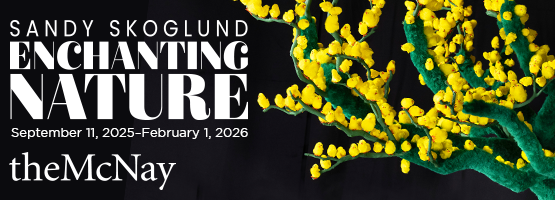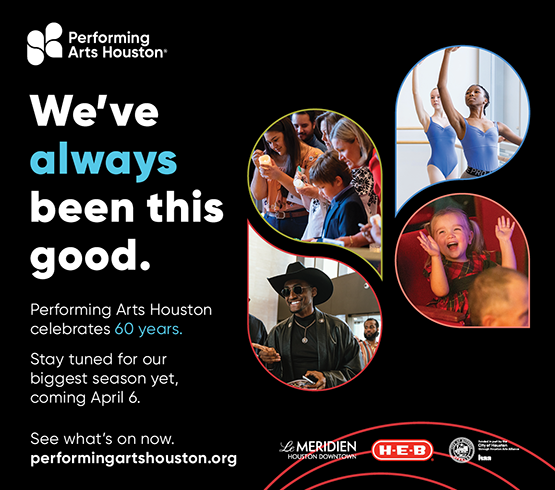Southern sensibilities influence a broad swath of contemporary art, with artists from the region gaining popularity for works that reference the rich histories and traditions of their homes only to have institutions ignore them.
First opened at the Virginia Museum of Fine Arts and on view at the Contemporary Art Museum Houston (CAMH) through Feb. 6, 2022, The Dirty South: Contemporary Art, Material Culture, and the Sonic Impulse is a survey of Southern art that shies away from nothing.
While many artists gain recognition and are celebrated for their work, that doesn’t always equate to their roots and history in the region. “This exhibition says, ‘You can’t strip these histories away,’” Cassel Oliver explains. The Dirty South opens with a sculptural installation by Nathaniel Donnett. “I looked over Jordan and what did I see; a band of angels coming after me” (2017) is a representation of the shotgun houses (or row houses) that dot the American South. With a machete hanging in the window, it highlights the history of Black presence and labor in the region.
The phrase “dirty south” has become a term of endearment for many people over the years. At its root, though, it’s a reference to the history held in the soil of the region. The blood, the sweat, the pain that course through the earth reverberate across time with new layers added every day. Still, through the aural rejuvenation of the term in the mid-1990s, people embraced it as a label that many now wear with pride.
In this way, Hip-hop is a bridge between past and present, connecting the history of the region to the modern state of Blackness in the South. Similarly, the exhibition bridges these two phases of the phrase. “It embraces every aspect of this history,” Cassel Oliver says. “It points to the South emerging from the earth, the labor that went into the earth, and the sociopolitical concerns that arise from it.”
For over a century, African American artists have explored the topography of the South. The culture is deeply embedded in the physical landscape, and over the years, this site of trauma has grown into a lush garden of creative expression.
The seeds were planted while Cassel Oliver lived in Houston as the curator of the CAMH. “I was in awe going through artists’ studios and seeing them embrace elements of the South: its traditions, history, reverberations,” she says. “They had a way of working that honored past traditions of the South through familial connections and artists who were forerunners of practices.”
As the seeds took root, she began to consider the throughlines and parallels of the work as well as the modes and materials they used. Many of the artists use a style of craft with deep roots in Southern culture.
In her Frustula series, artist Beverly Buchanan used cast-concrete markers to commemorate little-known events that took place in the rural South. The sculptures recall the ruins that litter the landscape of the region to highlight consciousness of place and history.
Similarly, other artists use their practices to build upon traditions and preserve techniques passed through communities.

1 ⁄5
RaMell Ross, Caspera, 2020.
Large scale archival pigment print, 40 x 60 inches. Image and work courtesy the artist.

2 ⁄5
Nadine Robinson, Coronation Theme: Organon, 2008. Speakers, sound system and mixed media, 175 x 18 1/2 x 174 inches. Image and work courtesy the artist and VMFA.

3 ⁄5
El Franco Lee, II, DJ Screw in Heaven 2, 2016.
Neon bulb and single-channel audio, 3:04 minutes, 60 x 60 inches. Image and work courtesy the artist.

4 ⁄5
Rodney McMillian, Asterisks in Dockery (Blues for Smoke), 2012. Vinyl, thread, wood, paint and lightbulb, 180 x 186 x 216 inches. Courtesy of the artist and Vielmetter Los Angeles. Photo by Brian Forrest.

5 ⁄5
John Biggers, Four Seasons, 1990, from “The Dirty South: Contemporary Art, Material Culture, and the Sonic Impulse” at the Virginia Museum of Fine Art.(John T. Biggers Estate / VAGA at Artists Rights Society)
Jamal Cyrus builds upon this tradition by utilizing a quilt to reconstruct a redacted document in A Witness, 2019, highlighting the remnants of an infamous FBI program that disrupted Black organizations for decades.
“With each successive generation, you see a different focal point,” Cassel Oliver said when asked about the trends she noticed over the span of the century of work in the exhibition. “Often there are seamless transitions from social justice to environmental justice or another concern. It confronts the idea of the South as a monolith because it’s not just about one thing.” The ideas and exploration behind the work spread as wide and broad as the artists themselves.
In her 2019 video piece Wacissa, Allison Janae Hamilton created a dizzying, haunting representation of the region’s troubled history. In the past, the Wacissa River was a part of Florida’s Slave Canal, which was used to transport cotton. More recently, the river transported the chemical runoff from factories in the area. The video shows travel through the river. The camera submerged underwater, viewers see the lush life that continues to propagate despite the brutal history of the area.
“These conversations are never static or occurring in a single point,” Cassel Oliver says. “Instead, they elongate over time.” The conversations among the works undulate across time. Sounds waft across the museum as though reaching out to each other, the blues, sermons, gospel all intermingling in the air.
Across the room, From Asterisks in Dockery, 2012, by Rodney McMillian invites visitors into a surreal, deep-red representation of a small wooden chapel known as the birthplace of the blues.
Downstairs, the exhibition explores the Black body as a home of cumulative traumas and an ever-regenerating vessel of culture and tradition. In Let Them Be Children, 2018, Deborah Roberts explores the impact of perception on community, constructing an ensemble of children quite literally out of preconceived notions. Their gestures vary, with some wary of their surroundings while others remain playful.
Together, the works showcase the depth, brutality, and beauty of the creative voices generated in the South. Still, Cassel Oliver recognizes there’s far more to examine.
“The journey has been long, and this is one small segment of it,” she reflected. “There’s a diverse, complex, rich history in the African American South that continues to evolve in a state of constant dynamism.”
—MICHAEL McFADDEN




